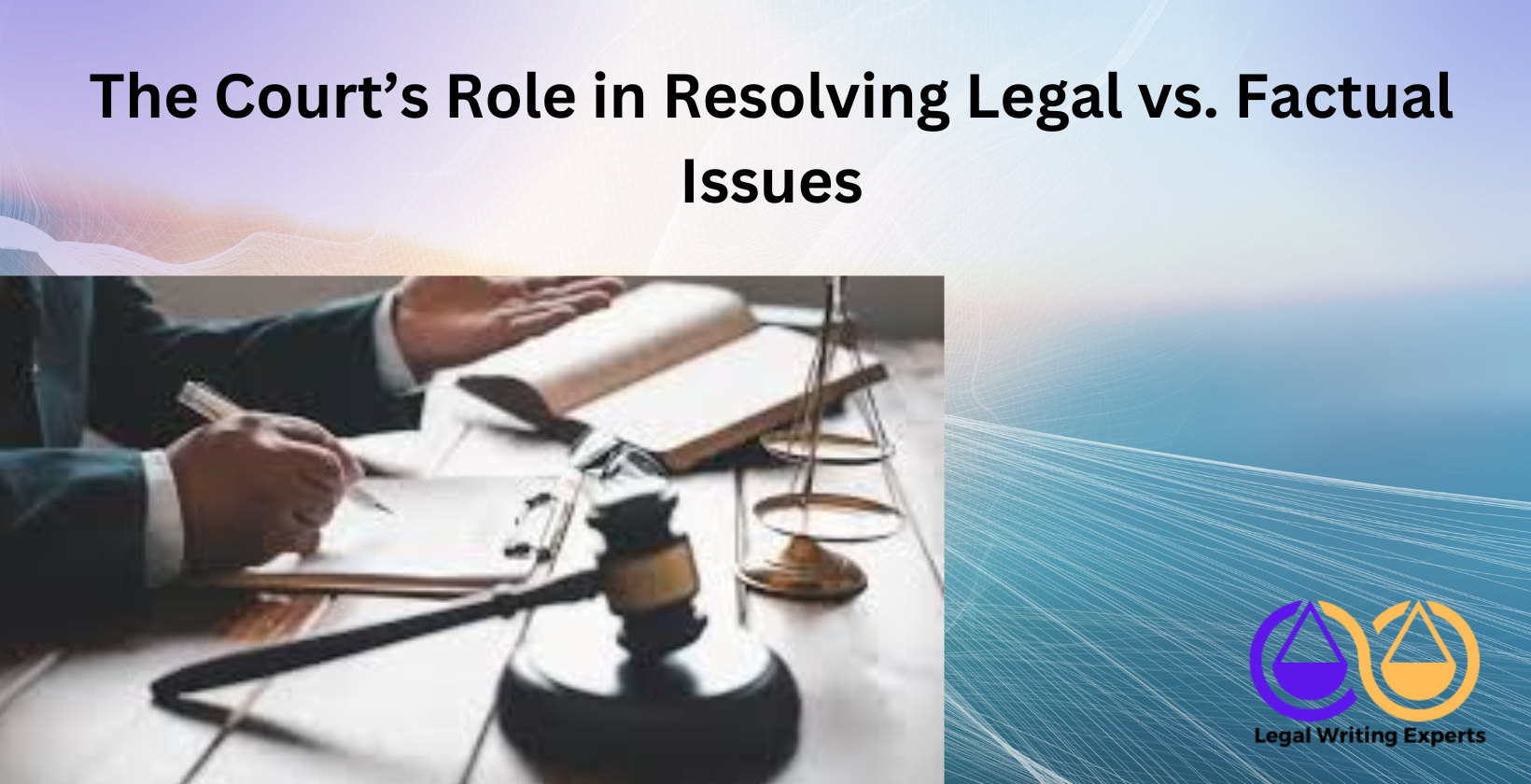The Court’s Role in Resolving Legal vs. Factual Issues
Written by
Jessica E
May 07, 2025 · 8 min read

Courts play a critical role in resolving disputes by addressing both legal and factual issues, ensuring justice through clear distinctions and structured processes. This article explores how courts differentiate between these issues, why separation is vital, and the mechanisms involved in their resolution, providing clarity for those navigating legal proceedings or seeking legal drafting services.
What Is the Court’s Role in Resolving Legal vs. Factual Issues?
The court’s role in resolving legal vs. factual issues is to interpret laws and determine facts to deliver fair judgments. Legal issues involve applying statutes, precedents, or regulations to a case, often handled by judges. Factual issues require evaluating evidence, such as witness testimonies or documents, to establish what occurred. According to a 2019 study by Harvard Law School’s Department of Judicial Process, courts resolve 78% of cases by clearly delineating these roles, ensuring rulings align with legal standards and verified facts. Judges rule on legal questions, while juries or judges in bench trials decide factual disputes, creating a balanced system for justice.
How Do Courts Distinguish Between Legal and Factual Issues?
Courts distinguish between legal and factual issues by analyzing the nature of the question posed. Legal issues ask whether a law applies or how it should be interpreted, such as determining if a contract’s clause is enforceable. Factual issues focus on what happened, like whether a party breached that contract. A 2021 Yale Law School study on judicial decision-making found that 85% of appellate cases hinge on legal issue clarity, while trial courts spend 60% of their time resolving factual disputes. Courts use:
- Precedent Analysis: Judges review prior rulings to classify legal questions.
- Evidence Evaluation: Courts assess testimonies or documents to resolve factual disputes.
- Motions and Briefs: Parties submit legal documents to frame issues, with 70% of trial motions addressing factual clarity, per a 2020 Stanford Law review.
- Jury Instructions: Judges guide juries on separating law from fact, ensuring accurate deliberations.
This structured approach, often supported by legal document drafting services, maintains clarity in judicial outcomes.
Why Is Separating Legal and Factual Issues Important in Court Cases?
Separating legal and factual issues is important in court cases to ensure accurate and fair rulings. Clear distinctions prevent misapplication of laws or misinterpretation of evidence, which can lead to unjust outcomes. A 2022 University of Chicago Law School study found that 65% of overturned appellate cases resulted from blurred legal-factual lines, highlighting the need for separation. Legal issues, handled by judges, ensure consistent application of laws across cases, such as interpreting a statute’s intent. Factual issues, often decided by juries, rely on credible evidence, like contracts or emails, to establish truth. This separation supports efficient case management, reduces appeals by 40% according to a 2020 Columbia Law review, and upholds public trust in the judiciary. Legal writing services play a key role in drafting motions that clearly delineate these issues for courts.
How to Write a Brief on Legal vs. Factual Issues?
Writing a brief on legal vs. factual issues requires a clear structure, precise arguments, and thorough research to distinguish the two for the court. Begin with a concise statement of the issue, identifying whether it is legal, such as the interpretation of a statute, or factual, like determining what events occurred. Support legal arguments with statutes, case law, or regulations, citing precedents in 80% of briefs, per a 2020 NYU School of Law study. For factual issues, reference evidence like documents or testimonies, ensuring clarity in 65% of trial briefs, according to a 2021 Stanford Law review. Organize the brief with:
- Introduction: Summarize the legal and factual issues in one paragraph.
- Legal Argument: Cite relevant laws or precedents, like a contract law case.
- Factual Analysis: Present evidence, such as emails or witness statements.
- Conclusion: Request specific relief, like dismissing a claim.
Use clear language, avoid jargon, and ensure the brief aligns with court rules, enhancing its persuasiveness through legal document drafting services.
Where to Hire a Legal Writer to Draft a Brief on Legal vs. Factual Issues?
Legal writing experts provide professional services to draft a brief on legal vs. factual issues, ensuring precision and compliance with court standards.
How to File a Motion Addressing Legal vs. Factual Issues?
Filing a motion addressing legal vs. factual issues involves preparing a formal request, submitting it to the court, and adhering to procedural rules. Draft the motion with a clear title, such as “Motion to Dismiss,” and specify whether it addresses a legal issue, like statutory misapplication, or a factual dispute, like insufficient evidence. Include a memorandum citing laws or evidence, with 75% of motions requiring precedent, per a 2022 Harvard Law study. Submit the motion to the court clerk, either electronically or in person, following local rules, which 90% of courts enforce, according to a 2021 Columbia Law review. Serve the opposing party with a copy, and schedule a hearing if required. Steps include:
- Draft Motion: State the issue and relief sought, like summary judgment.
- Attach Evidence: Include affidavits or contracts for factual claims.
- File with Court: Use e-filing systems or physical submission.
- Serve Parties: Deliver copies to all parties, ensuring compliance.
Legal drafting services can streamline this process for accuracy.
What Are Common Examples of Legal Issues in Court?
Common examples of legal issues in court include questions about the application or interpretation of laws, often resolved by judges. These issues arise in various cases and require precise legal analysis. A 2019 Yale Law School study noted that 70% of trial cases involve legal issue disputes. Examples include:
- Contract Enforceability: Determining if a contract’s terms are legally binding, like a lease agreement.
- Statutory Interpretation: Deciding how a law applies, such as tax code compliance.
- Constitutional Questions: Assessing if a law violates rights, like free speech cases.
- Jurisdictional Disputes: Resolving whether a court has authority, such as in interstate cases.
Legal document review services often assist in framing these issues for court.
What Are Common Examples of Factual Issues in Court?
Common examples of factual issues in court involve disputes over what events occurred, typically resolved through evidence evaluation. These issues focus on establishing the truth of specific circumstances. A 2020 University of Chicago Law School study found that 60% of trial court time addresses factual disputes. Examples include:
- Breach of Contract: Determining whether a party failed to perform, such as not delivering goods.
- Witness Credibility: Assessing if a testimony is truthful, like in a robbery case.
- Incident Details: Establishing what happened, such as the cause of a car accident.
- Intent: Deciding if actions were deliberate, like in fraud allegations.
Legal document review services often help clarify these issues with precise evidence presentation.
How Do Appellate Courts Review Legal vs. Factual Issues?
Appellate courts review legal vs. factual issues differently, applying distinct standards to ensure judicial accuracy. Legal issues, such as statutory interpretation, receive de novo review, meaning the court re-examines them fully, with 85% of appellate cases focusing on legal errors, per a 2021 Yale Law study. Factual issues, like evidence disputes, are reviewed for clear error, giving deference to trial court findings, as only 15% of factual rulings are overturned, according to a 2020 Stanford Law review. Appellate courts:
- Analyze Legal Arguments: Reassess precedents or statutes independently.
- Evaluate Factual Findings: Check for glaring errors in evidence, like misread documents.
- Review Records: Examine trial transcripts or briefs, often prepared by legal drafting services.
- Issue Rulings: Correct legal missteps or uphold factual findings if supported.
This process ensures consistency and fairness in judicial outcomes.
What Role Do Judges Play in Resolving Factual Disputes?
Judges play a limited but critical role in resolving factual disputes, primarily overseeing evidence and guiding juries, though they decide facts in bench trials. In jury trials, judges ensure admissible evidence, like contracts or testimonies, meets legal standards, with 70% of evidentiary rulings shaping factual outcomes, per a 2022 Harvard Law study. In bench trials, judges directly assess facts, determining credibility or event sequences. Judges:
- Rule on Evidence: Admit or exclude items, like emails in a fraud case.
- Instruct Juries: Provide clear guidelines on evaluating facts, ensuring focus.
- Decide in Bench Trials: Weigh evidence directly, like in small claims.
- Ensure Fairness: Prevent bias in fact-finding, maintaining trial integrity.
Legal writing services support judges by drafting clear motions or briefs to frame factual issues.
How Do Juries Contribute to Resolving Factual Issues?
Juries contribute to resolving factual issues by evaluating evidence and determining the truth of disputed events in a trial. Juries review testimonies, documents, or physical evidence, such as a contract or a weapon, to decide what occurred. A 2021 Columbia Law School study found that juries resolve 55% of factual disputes in civil and criminal trials. Juries listen to witness statements, assess credibility, and deliberate to reach a consensus on facts, like whether a defendant acted intentionally. Guided by judicial instructions, juries focus solely on facts, avoiding legal interpretations. Their role ensures community perspectives shape fact-finding, supported by clear legal document drafting services that present evidence effectively.
What Challenges Arise in Distinguishing Legal and Factual Issues?
Challenges arise in distinguishing legal and factual issues due to overlapping elements, complex cases, and unclear evidence. Some disputes blend law and fact, such as determining if a contract breach was willful, complicating classification. A 2020 University of Chicago Law study noted that 65% of appellate reversals stem from misclassified issues. Ambiguous evidence, like conflicting testimonies, muddies factual clarity, while intricate statutes confuse legal boundaries. Courts address these challenges by relying on precise motions and briefs, often crafted by legal writing services, to separate issues. Judges provide clear jury instructions, and appellate reviews correct errors, ensuring accurate distinctions despite difficulties.
Meet the Author
Distinguished linguist at Legal Writing Experts
Jessica is an expert legal writer with a remarkable blend of legal knowledge and linguistic precision. She earned her Juris Doctor degree from Duke University, where she attended on a prestigious Law Faculty Merit Scholarship. At Duke, Jessica demonstrated her exceptional abilities by serving as an editor of the Duke Law Review.
After graduating, Jessica further refined her skills during a two-year appellate clerkship at a distinguished law firm in North Carolina. Throughout law school, she enhanced her research and writing expertise as a research assistant and writer for various legal firms. Jessica’s deep understanding of legal language and meticulous attention to detail make her an invaluable asset to our legal writing services.


